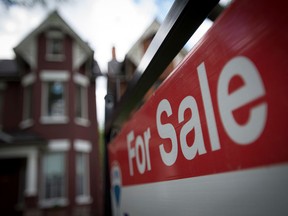Home prices have fallen in Canada, yet at the same time buying a home is becoming more unaffordable.
So how does that work?
Rising mortgage rates, and thus higher qualifying rates under the mortgage stress test are increasing how much income Canadians need to buy a home even as prices weaken in most markets, says a new report from rate comparison site Ratehub.ca.
Home affordability declined in all of the 10 cities studied in the analysis which was based on monthly real estate data between August and September from the Canadian Real Estate Association.
Rising five-year bond yields that have hit highs not seen since 2007 are pushing fixed mortgage rates steadily higher, said the report. The prime rate has climbed to 7.2 per cent as the Bank of Canada raised its benchmark interest rate to 5 per cent.
Ratehub.ca says between August and September the average mortgage rate increased from 6.22 per cent to 6.33 per cent, meaning that many mortgage applicants are now being stress tested at 8.3 per cent or higher.
Canada’s mortgage stress test, introduced in 2016, requires borrowers to qualify at a rate of 5.25 per cent or the lenders’ offer plus two per cent, whichever is higher.
“The stress test is the highest it has ever been, exceeding the high water mark that was set last month,” says James Laird, co-chief executive of Ratehub.ca and president of CanWise mortgage lender.
“Home values dropped in all 10 cities we looked at, yet still became less affordable. August to September data highlights how impactful even a minor rate increase is on affordability.”
The mortgage rate increase was enough to decrease affordability for the average buyer in markets across Canada, said the report.
Vancouver residents saw the biggest rise. Though the average home price in this city declined by $5,100 in September, the income needed to buy it rose by $3,900 from $246,100 in August to $250,000.
Home prices fell the most in Toronto, dropping $14,400, but the income needed to buy one increased by $1,800 to $235,100.
Hamilton over past months had bucked the trend of deteriorating affordability, said Ratehub.ca, but in September the average income required grew by $1,640 to $181,800, despite home values dipping by $9,500.
A survey commissioned by ratefilter.ca found that 62 per cent of Canadians exceed the Canada Mortgage and Housing Corporation’s recommended guideline of spending no more than 30 per cent of pre-tax income on housing, with homeowners with a mortgage devoting 41 per cent.
More than half of the people polled with a mortgage said they would miss a payment within three months if they lost their job, while 16 per cent said they would fall behind on payments within 30 days.
“These statistics corroborate what we’ve been hearing anecdotally,” said Andy Hill, co-founder of ratefilter.ca. “Many Canadians feel like they’re at a breaking point due to higher interest rates. Even if the Bank of Canada pauses the rate hike, these borrowers will still be dealing with rates at a 20-year high.”
There will be little relief for home buyers until the Bank of Canada starts to cut rates, said Laird.
“Home values are going to need to drop a lot more to offset the impact of the sharp rate increases.”

Bond markets have been on a wild ride this week, with the U.S. 10-year yields soaring more than 30 basis points to reach 4.98 per cent yesterday. Yields eased back after chair Jerome Powell signalled the Federal Reserve will proceed carefully with interest rate hikes, but the rates sell-off this year has been one for the history books. Today’s chart from BofA Global Research looks back on previous decades to give some context to this bond market meltdown.













